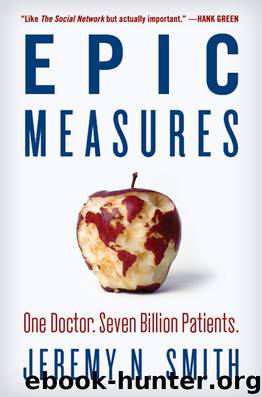Epic Measures : One Doctor, Seven Billion Patients (9780062237521) by Smith Jeremy N

Author:Smith, Jeremy N.
Language: eng
Format: epub, mobi
Publisher: HarperCollins
Published: 2015-02-23T16:00:00+00:00
By January 2012, four and a half years after Murray, Gakidou, and MacIntyre had arrived in Seattle, the start of the year in which the new Global Burden study results would absolutely, positively, no excuses, be delivered, the project had grown much larger and become truly global: fifty full-time faculty and staff at IHME; nearly five hundred co-authors in fifty different countries; regular consultations with decision makers on six continents. Even as Murray traveled to Geneva, Washington, D.C., Brasilia, Dhaka, Beijing, Canberra, Auckland, Boston, Atlanta, and Lusaka to share preliminary findings with key public health officials, he and his team raced to process the entirety of their research for final analysis. The Razor scooter had long since been retired as a management tool, and so had the idea of waiting until the end of a project to explain it to everyone. These days, a stranger walking the halls of IHME could observe a color flow chart on almost every desk indicating that person’s part of the big picture. Put them together and, like the blueprint for a space telescope, you saw the data and methods necessary to bring the new Global Burden into operation. Still, Murray obsessed over every detail—and kept increasing the study’s scope.
In earlier versions, the most sweeping burden-of-disease studies had tracked approximately 100 health problems for one year in eight global regions. In his 2007 grant application to the Gates Foundation, Murray had said the new Global Burden of Disease study would cover 200 diseases and injuries, two different time periods, and twenty-one regions of the world. Now, he wanted to tally 291 ailments and 67 risk factors by age and sex in 187 world countries, charting back over decades. Death’s work would be calculated every year from 1990 to 2010, and the swath of illness and injury for every man, woman, and child in 1990, 2005, and 2010. Some estimates, such as life expectancy by age and sex and country, would go back as far as 1970. And the results would be public. It was an open question whether the hundreds of people trying to complete Global Burden could outpace their leader’s determined efforts to expand it.
While they were compiling data, Global Burden researchers were also refining their methods. Since Sudhir Anand and Kara Hansen’s early Pop Center critique, some four hundred papers had been published on ethical choices in how DALYs were calculated. In July 2011, Murray had convened a meeting of twenty philosophers, ethicists, and economists to discuss the topic. Following their strong consensus recommendation, age weighting (valuing years lived in midlife greater than in childhood or old age) and a related calculation, discounting, were dropped from Global Burden. Among other virtues, the change meant that how DALYs were determined was even easier to explain to policy makers and the public. Assuming an ideal life span of eighty-six years, “If you die at age ten, you’ve lost seventy-six years,” said Murray. “If you have a disability of 0.2, you’ve lost 0.2 years.”
Skeptics had long attacked the very idea of weighting different disabilities.
Download
Epic Measures : One Doctor, Seven Billion Patients (9780062237521) by Smith Jeremy N.mobi
This site does not store any files on its server. We only index and link to content provided by other sites. Please contact the content providers to delete copyright contents if any and email us, we'll remove relevant links or contents immediately.
Periodization Training for Sports by Tudor Bompa(8170)
Why We Sleep: Unlocking the Power of Sleep and Dreams by Matthew Walker(6618)
Paper Towns by Green John(5089)
The Immortal Life of Henrietta Lacks by Rebecca Skloot(4525)
The Sports Rules Book by Human Kinetics(4290)
Dynamic Alignment Through Imagery by Eric Franklin(4116)
ACSM's Complete Guide to Fitness & Health by ACSM(3989)
Kaplan MCAT Organic Chemistry Review: Created for MCAT 2015 (Kaplan Test Prep) by Kaplan(3939)
Introduction to Kinesiology by Shirl J. Hoffman(3725)
Livewired by David Eagleman(3683)
The Death of the Heart by Elizabeth Bowen(3551)
The River of Consciousness by Oliver Sacks(3538)
Alchemy and Alchemists by C. J. S. Thompson(3449)
Bad Pharma by Ben Goldacre(3355)
Descartes' Error by Antonio Damasio(3230)
The Emperor of All Maladies: A Biography of Cancer by Siddhartha Mukherjee(3064)
The Gene: An Intimate History by Siddhartha Mukherjee(3047)
The Fate of Rome: Climate, Disease, and the End of an Empire (The Princeton History of the Ancient World) by Kyle Harper(3003)
Kaplan MCAT Behavioral Sciences Review: Created for MCAT 2015 (Kaplan Test Prep) by Kaplan(2936)
